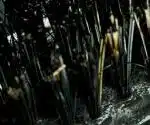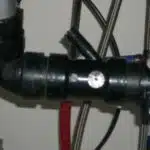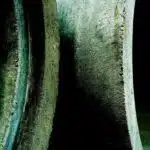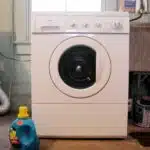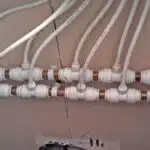Plumbing issues are a common problem in households that can cause serious inconvenience to homeowners. Blocked drains are one such issue which can lead to unpleasant odors, water damage, and even health hazards. In such situations, using a plumbing snake is an effective solution for unclogging the drain. As a plumbing technician, it is essential to understand the proper usage of the plumbing snake to ensure efficient and safe results.
The plumbing snake is a flexible cable that consists of a coiled metal wire with an auger attached at one end. When inserted into the drain, the auger breaks down any blockages and clears the pipe by pulling out debris or pushing it further down into the sewer line. It is an ideal tool for unclogging drains as it provides greater reach than traditional plungers and does not require harsh chemicals that can be harmful to pipes and humans. However, using a plumbing snake requires precision and expertise to avoid damaging your pipes or causing more severe problems. This article will provide detailed instructions on how to use a plumbing snake safely and effectively.
Understanding The Anatomy Of A Plumbing Snake
Plumbing snakes come in different types, each with a specific purpose. The most common type is the hand-cranked snake or auger, which is made of coiled wire and has a handle on one end for turning. Another type is the power snake, which uses an electric motor to rotate the wire coil. Lastly, there are closet augers that are specifically designed for unclogging toilets.
Proper maintenance of your plumbing snake increases its lifespan and effectiveness in clearing clogs. After using it, clean the snake thoroughly with hot water and soap to remove any debris or residue. It’s also advisable to lubricate it with oil before storing it away to prevent rusting.
Regular maintenance of your plumbing snake not only prolongs its lifespan but also ensures that it works effectively when you need it most. Knowing how to choose the right type of plumbing snake for your needs and how to maintain it properly will make all the difference in successfully unclogging drains. Let’s now move on to knowing when to use a plumbing snake.
Knowing When To Use A Plumbing Snake
Determining the right time to use a plumbing snake is critical in ensuring that your drain unblocking efforts are successful. Signs of severe blockages include slow drainage or no drainage at all, gurgling sounds from the pipes, and unpleasant odors emanating from the drains. If you notice any of these signs, it is essential to act fast and unclog your drains using a plumbing snake.
Different types of plumbing snakes are available for use depending on the type of drain blockage. The most common type is the hand-held auger which can clear out minor clogs in smaller drains such as sinks and showers. For more challenging blockages in larger pipes such as sewer lines, a power auger may be necessary. A toilet auger, also known as a closet auger, is specially designed for clearing clogs in toilets.
Before using a plumbing snake, it is crucial to have an understanding of its different types and their applications. Failure to choose the right kind could lead to further damage to your pipes or even injury during the unclogging process. Knowing when to use a plumbing snake coupled with an understanding of its different types will ensure that your drain unblocking efforts are successful without causing any harm or further damage to your plumbing system.
As you prepare to unclog your drains using a plumbing snake, it is vital that you gather all the necessary tools and equipment needed for the job.
Gathering The Necessary Tools And Equipment
Knowing when to use a plumbing snake is just the first step in unclogging a drain. The next step is gathering the necessary tools and equipment, which includes choosing the right plumbing snake. Not all plumbing snakes are created equal, so it’s important to select one that’s appropriate for the type of clog you’re dealing with.
There are two main types of plumbing snakes: hand-operated and motorized. Hand-operated snakes are manually cranked while motorized ones use electricity or battery power to spin the cable. For most household clogs, a hand-operated snake is sufficient. However, if you’re dealing with a particularly tough blockage or need to reach deep into your pipes, a motorized snake may be necessary.
Once you have your plumbing snake in hand, it’s important to handle it properly in order to effectively unclog your drain. First and foremost, always wear gloves and eye protection when using a plumbing snake. This will protect you from any debris that may fly back at you during the process. Additionally, make sure you’re feeding the cable into the drain slowly and steadily while applying gentle pressure. Jerking or forcing the cable can cause it to get stuck or break off inside your pipes, creating an even bigger problem than before.
Preparing the drain for snaking involves removing any visible debris or buildup around the opening so that the snake can easily access and work through any blockages further down in the pipes. This may involve using a plunger beforehand or simply removing any hair or gunk that has collected near the surface of the drain. Once this initial preparation is complete, it’s time to start snaking! Remember to take your time and be patient as you navigate through your pipes – rushing through this process could result in more damage than good.
Preparing The Drain For Snaking
Did you know that one of the most common reasons for clogged drains is a buildup of hair and soap scum? This can cause water to back up and lead to unpleasant odors. Clearing obstructions and removing debris buildup is essential in preparing the drain for snaking. Before starting, ensure that there is no standing water in the sink or tub.
To begin preparing the drain for snaking, remove any visible debris, such as hair or food particles, using a pair of pliers or tweezers. Next, flush hot water down the drain to help dissolve any remaining buildup. If this doesn’t work, use a mixture of baking soda and vinegar to break up stubborn clogs. Pour half a cup of baking soda down the drain followed by half a cup of vinegar, then cover the drain with a plug and let it sit for 30 minutes before flushing with hot water.
Finally, if none of these methods work, it’s time to move onto using a plumbing snake. But before inserting the snake into the drain, make sure that you have cleared out any visible debris and attempted to dissolve any remaining buildup. This will make it easier for the snake to navigate through the pipes and effectively remove any blockages. With your drain now prepared for snaking, let’s dive into how to properly insert a plumbing snake into your drain.
Inserting The Plumbing Snake Into The Drain
After properly preparing the drain for snaking, it’s time to insert the plumbing snake into the drain. This is where proper technique is crucial in order to effectively unclog the drain. One of the most common mistakes when using a plumbing snake is not inserting it far enough into the drain. This can result in only pushing the blockage further down the pipe instead of removing it.
Different types of plumbing snakes are available on the market, and choosing the right one depends on various factors such as the type of clog and size of the drain. For instance, a handheld drum auger is ideal for small to medium-sized drains while a motorized auger is better suited for larger drains with tougher clogs. It’s important to choose a snake that is long enough to reach the blockage without damaging your pipes.
Once you have chosen the right type of plumbing snake and inserted it into the drain, maneuvering it through the blockage requires patience and skill. Slowly turn and push the auger forward while applying gentle pressure until you feel resistance from the blockage. At this point, stop pushing and begin rotating or cranking your snake handle clockwise or counter-clockwise depending on your machine’s instruction manual. With this motion, you should be able to break up or remove any obstructions in your pipes.
Now that we’ve covered how to properly insert a plumbing snake into a drain, let’s move onto maneuvering through blockages with ease.
Maneuvering The Auger Through The Blockage
As you maneuver the auger through the blockage, it’s important to visualize what’s happening inside the drain. Imagine a tight, winding tunnel filled with debris and buildup that’s been preventing water from flowing freely. The auger is your tool for breaking up this blockage and clearing a path for water to escape. As you work, keep in mind that patience and persistence are key.
Tips for beginners include taking breaks when necessary to avoid frustration or fatigue. It’s also important to pay attention to the sound and feel of the auger as it moves through the drain. If you hear or feel resistance, stop immediately and assess the situation before continuing.
Common mistakes include applying too much force or attempting to force the auger through a particularly stubborn blockage. Remember that slow and steady wins the race when it comes to using a plumbing snake. Be patient, take your time, and allow the auger to do its job.
As you continue working on unclogging your drain, be mindful of how much pressure you’re applying with each rotation of the auger. In our next section, we’ll discuss how to apply just enough pressure to break up stubborn clogs without causing damage to your pipes.
Applying The Right Amount Of Pressure
When using a plumbing snake, it is important to apply consistent pressure throughout the process. You want to avoid using excessive force that could damage your pipes or push the clog further down. It is recommended that you start with gentle pressure and gradually increase as needed.
If you encounter resistance while snaking, do not force the snake through. This may cause it to become stuck, making it even more difficult to remove the clog. Instead, try changing the angle of entry or rotating the snake slightly to find a better path through the blockage.
To ensure that you are applying consistent pressure, hold onto both ends of the plumbing snake and use a slow and steady motion. Avoid jerking or pulling too hard as this can cause damage to your pipes or potentially injure yourself in the process.
- Keep your body positioned properly to prevent straining your back
- Wear protective gloves to avoid injury from sharp edges
- Use caution when snaking around bends in pipes
- Always turn off water supply before starting any work on drains
- Have a bucket nearby to catch any water that may overflow during the unclogging process
With these tips in mind, you can safely and effectively use a plumbing snake to unclog your drains without causing any additional damage. In the next section, we will discuss how rotating the plumbing snake can help navigate tricky blockages.
Rotating The Plumbing Snake
- Inserting the plumbing snake requires careful handling and careful consideration of the working environment.
- Once inserted, the plumbing snake should be slowly rotated in order to dislodge any blockages in the drain.
- When operating the plumbing snake, it is important to maintain a consistent speed and pressure to ensure the snake is able to penetrate the blockage.
- It may be necessary to adjust the speed or pressure of the snake if the blockage is not dislodged after the initial attempts.
Inserting The Plumbing Snake
Before we discuss the proper technique for inserting the auger into a drain, it is essential to understand the different types of plumbing snakes available. There are two main types of plumbing snakes: hand-operated and electric-powered. Hand-operated snakes are typically used for smaller drains such as sinks and showers, while electric-powered snakes are ideal for larger drains like main sewer lines. Once you have identified the type of plumbing snake needed for your clogged drain, it’s time to insert it properly.
To insert the auger into a drain, begin by removing the drain cover or stopper. Next, slowly feed the snake down into the drain, being careful not to force it too quickly or aggressively. It’s important to maintain a steady pressure on the snake while inserting it, as this will help prevent any damage to your pipes. As you continue to insert the snake, be prepared to encounter some resistance from any blockages in your pipes.
As you reach the blockage, gently twist and turn the handle of your plumbing snake while continuing to apply pressure. This rotating motion will help break up any debris and allow you to move past the clog. Be cautious not to rotate too hard or fast, as this could cause damage or further blockages in your pipes. With patience and persistence, you should be able to successfully insert your plumbing snake and begin clearing away any obstructions that are causing your drain to back up.
Operating The Plumbing Snake
Now that we have discussed the proper technique for inserting the auger into a drain, it’s time to move on to operating the plumbing snake. Understanding snake types is vital, but using them correctly is equally important. The key to successfully clearing your clogged drain is proper maintenance techniques and knowing when to rotate the plumbing snake.
When encountering a blockage, gently twisting and turning the handle of your plumbing snake while continuing to apply pressure is crucial. This rotating motion will help break up any debris and allow you to move past the clog without causing damage or further blockages in your pipes. It’s essential not to rotate too hard or fast as this could cause harm or push the obstruction further down the pipe. With patience and persistence, you should be able to clear away any obstructions that are causing your drain to back up.
In conclusion, operating a plumbing snake can be challenging; however, with proper understanding of snake types and maintenance techniques together with cautious handling of your equipment, anyone can do it. Remember always to wear gloves when handling a plumbing snake as they can be filthy from previous usage. If you’re unsure about operating one yourself or encounter complex issues during use, calling in professional plumbers will always be an option.
Pulling Out The Debris
After rotating the plumbing snake, you should have successfully broken down the blockage in your drain. Next, it’s time to remove any debris that may be left behind. This step is crucial in ensuring that your drain is completely unclogged and free-flowing.
To remove debris, slowly pull out the plumbing snake while simultaneously rotating it. This will help catch any remaining debris and bring it to the surface. Once you have removed as much debris as possible, it’s important to dispose of it properly. Do not simply throw it in the trash or flush it down the toilet, as this can create further plumbing problems down the line.
Proper disposal techniques include placing the debris in a plastic bag and throwing it in the garbage or bringing it to a waste management facility. By following these steps carefully, you can ensure that your drain is fully unclogged and functioning properly once again. Now, let’s move on to flushing the drain to check for any remaining blockages.
Flushing The Drain To Check For Blockages
After using a plumbing snake to clear out any blockages, it is important to flush the drain to check for any remaining obstructions. Flushing the drain involves running water through the pipes to ensure that water flows smoothly and there are no signs of reduced drainage. The importance of drain maintenance cannot be overstated as clogged drains can lead to other serious plumbing problems.
Signs of a clogged drain include slow draining sinks, foul odors emanating from drains, and gurgling sounds coming from the pipes. Ignoring these signs can lead to severe blockages that may require costly repairs or even replacement of entire sections of pipe. It is recommended that homeowners perform regular maintenance on their drains by using simple techniques such as pouring boiling water down the drain or using vinegar and baking soda.
To prevent clogs from occurring in the future, it is important to be mindful of what goes down your drains. Avoid pouring grease, oil, or food particles down kitchen sinks and dispose of them properly instead. In bathrooms, use a hair catcher in shower and sink drains to prevent hair from accumulating and causing blockages. By taking these preventative measures, you can save yourself time and money in the long run.
By flushing the drain after using a plumbing snake, you can ensure that your pipes are fully cleared of any obstructions. However, if you notice any signs of reduced drainage or foul smells after flushing the drain, it may be necessary to repeat the process. This will help ensure that your pipes remain free from blockages and continue functioning efficiently for years to come.
Repeating The Process If Necessary
After flushing the drain to check for blockages, it’s time to move onto the next step: using a plumbing snake. This tool is designed to break up any stubborn clogs that have built up in your pipes. As the idiom goes, “Time to get down to brass tacks,” so let’s get started.
Before using a plumbing snake, it’s important to understand how they work. A plumbing snake is a long, flexible cable that has a coiled metal wire at one end and a handle at the other end. The coiled wire is inserted into the drain and then rotated by hand or with an electric motor. As it rotates, it breaks up any clogs and clears the way for water to flow freely again.
To use a plumbing snake properly, follow these steps:
| Step | Description |
|---|---|
| 1 | Insert the snake into the drain |
| 2 | Rotate the handle clockwise while pushing forward |
| 3 | If you feel resistance, rotate counterclockwise |
| 4 | Continue until you feel the clog break up |
Using chemical drain cleaners can be tempting when faced with a stubborn clog, but they should be used sparingly if at all. These cleaners contain harsh chemicals that can damage your pipes over time and are also harmful to the environment. Preventing future drain clogs can be achieved by being mindful of what you put down your drains. Avoid pouring grease, oil, coffee grounds, and other food scraps down the sink as they can build up over time and cause blockages.
In order to ensure that your plumbing snake lasts for years to come, it’s important to clean and store it properly after each use. Cleaning involves wiping down the cable with a rag or paper towel and applying lubricant if necessary. Storing involves coiling up the cable neatly and keeping it in a dry place away from extreme temperatures. By taking good care of your plumbing snake, you can rely on it to help keep your drains clear for years to come.
Cleaning And Storing The Plumbing Snake
After using your plumbing snake to unclog a drain, it is essential to clean and store the tool properly. Cleaning techniques vary depending on the type of snake you have. For manual snakes, simply wipe down the cable with a cloth or paper towel to remove any debris or residue. For electric snakes, use a damp cloth to wipe down the cable and motor housing.
To prevent damage and ensure longevity, proper storage solutions are necessary for your plumbing snake. Manual snakes can be coiled up and stored in a bucket or other container. Electric snakes should be disassembled and stored in their respective cases, which usually come with the tool when purchased. When storing either type of snake, make sure they are kept in a dry location away from extreme temperatures.
Cleaning and storing your plumbing snake is crucial for its effectiveness and longevity. Neglecting these steps can lead to rust, damage, or even breakage of the tool. By taking care of your plumbing snake after use, you will save money in replacement costs and reduce the likelihood of needing professional plumbing services.
Moving forward, if you encounter any issues while using your plumbing snake, there are common troubleshooting techniques that can help resolve them quickly.
Troubleshooting Common Issues
- The use of a plumbing snake is an effective method to clear hair clogs from drains.
- A plumbing snake can be used to dislodge grease buildup and other blockages from a drain.
- The use of a plumbing snake to remove foreign objects is a delicate process that should be conducted with caution.
- The plumbing snake should be inserted into the drain to reach the clog and push it through.
- When using a plumbing snake to clear hair clogs, it is important to ensure that the clog is completely broken up and flushed away.
- Grease buildup from food particles can be effectively removed with a plumbing snake when used in a circular motion.
Clearing Hair Clogs
One of the most common causes of clogged drains is hair buildup in the pipes. As a plumbing technician, it’s important to know how to effectively clear hair clogs using a plumbing snake. To begin, remove any visible hair from the drain with gloves or a tool like needle-nose pliers. Next, insert the snake into the drain and turn it clockwise while pushing forward. This will help break up the hair and allow it to move through the pipes.
Removing soap scum is another important step in preventing future clogs caused by hair buildup. Soap scum can accumulate on top of hair and create a solid blockage in your pipes over time. To prevent this from happening, use an enzyme-based drain cleaner once a month to break down any soap scum or other organic matter that may be collecting in your pipes.
In conclusion, clearing hair clogs requires patience and attention to detail – but it is possible when using a plumbing snake correctly. By removing visible hair and breaking up any remaining buildup with the snake, you can restore proper water flow through your pipes. And by taking steps to prevent future clogs, such as removing soap scum regularly, you can ensure that your drains stay clear for years to come.
Unblocking Grease Buildup
As a plumbing technician, it’s important to understand the different causes of clogged drains and how to effectively troubleshoot them. One common issue that homeowners face is grease buildup in their pipes. Grease can accumulate over time and create stubborn blockages that prevent water from flowing properly. To address this problem, it’s crucial to take steps to remove the existing buildup and prevent future clogs.
Removing stubborn buildup requires a multi-step approach. First, it’s important to identify the location of the blockage by using tools like drain cameras or pipe locators. Once you’ve located the blockage, you can use a plumbing snake or hydro jetting equipment to break up and remove the grease. It may be necessary to repeat this process multiple times depending on the severity of the buildup.
Preventing future clogs caused by grease buildup is equally important. One effective method is to avoid pouring grease down your drains altogether. Instead, collect excess cooking oil in a container and dispose of it in your regular trash. Additionally, using enzyme-based drain cleaners once a month can help break down any remaining organic matter in your pipes and keep them flowing smoothly. By taking these steps, you can ensure that your pipes stay clear and functioning properly for years to come.
Removing Foreign Objects
As a plumbing technician, it’s important to be well-versed in troubleshooting common issues that homeowners face. In addition to grease buildup, another issue that can cause significant problems is foreign objects clogging the pipes. These objects can include anything from hair and soap scum to toys and other debris. To effectively remove these blockages and prevent them from happening in the future, there are several steps you can take.
To begin with, it’s essential to identify the location of the blockage by using specialized tools like drain cameras or pipe locators. Once you’ve located the foreign object, you can use a plumbing snake or hydro jetting equipment to break it up and remove it from the pipe. It may be necessary to repeat this process several times depending on the type of object and how deeply it is embedded in the pipe.
Preventing future clogs caused by foreign objects requires some simple lifestyle changes. For example, removing hair from your shower or sink drains after each use can go a long way towards preventing blockages. Additionally, using a drain strainer or filter can help catch larger debris before it enters your pipes. By taking these proactive steps, you can save yourself time and money in costly repairs down the line while ensuring that your pipes continue functioning smoothly for years to come.
Safety Precautions To Consider
When it comes to using a plumbing snake, safety should be your top priority. It is crucial that you wear protective gear to prevent any potential injuries that may occur during the process. While the snake may appear harmless, it can cause serious harm if not used properly. Therefore, it is essential to take the necessary precautions before starting the unclogging process.
One of the most common mistakes when using a plumbing snake is failing to wear protective gear. This can lead to injuries from exposure to hazardous materials or even physical harm due to improper handling of the snake. To avoid this mistake, always make sure you have on gloves, safety glasses, and long sleeves before beginning your work. These items will protect your skin and eyes from any harmful substances that may come into contact with them.
Another mistake that many people make when using a plumbing snake is failing to read and understand the instructions before use. This can lead to improper usage, which could result in further damage or clogs in your drain system. To avoid this issue, always read and follow the manufacturer’s instructions carefully before attempting to use the snake. Doing so will help ensure that you are using it correctly and safely so that you can get your drain unclogged without causing any additional problems.
When it comes down to it, taking these safety precautions is vital for anyone who wants to use a plumbing snake effectively and safely. However, if you find that these measures are not sufficient for unclogging your drains, it might be time to call in a professional plumber who has more experience with this type of work. In the next section, we’ll discuss some of the signs indicating when you should consider hiring a professional plumber instead of trying DIY methods such as using a plumbing snake on your own.
When To Call A Professional Plumber
Signs of a severe clog may include water backing up in your sink or toilet, slow draining, unpleasant odors, or gurgling noises coming from the drain. If you have tried to clear the clog with a plumbing snake and it persists, it may be time to call in a professional plumber. Similarly, if you notice multiple drains in your home are clogged at once, this could indicate a larger issue that requires the expertise of a plumber.
When deciding whether to call a professional plumber or attempt to fix the problem yourself, it is important to consider cost. While using a plumbing snake may seem like an affordable solution, if used incorrectly it can cause damage to your pipes which can lead to costly repairs down the line. Additionally, if the problem persists after attempting DIY solutions, calling in a plumber early on can save you money by preventing further damage and complications.
The cost of calling a professional plumber will vary depending on several factors such as the severity of the issue and location of the clog. On average, however, homeowners can expect to pay anywhere from $150 to $450 for drain cleaning services. While this may seem costly upfront, investing in professional services can save you money in the long run by avoiding more expensive repairs and ensuring that your plumbing system is functioning properly.
Conclusion
Understanding the anatomy of a plumbing snake is crucial in effectively unclogging drains. Knowing when to use one, gathering the necessary tools and equipment, and properly preparing the drain for snaking are all important steps to ensure success. Inserting the snake into the drain and cleaning it afterwards are also critical steps that must be done with care.
It’s important to remember that despite taking these precautions, issues may still arise. Troubleshooting common issues and being aware of safety precautions can help to prevent further problems. However, if all else fails, it may be necessary to call a professional plumber who has the expertise and specialized tools needed to fix any plumbing issues.
As a plumbing technician, it is our duty to provide effective solutions for our clients’ plumbing needs. Utilizing a plumbing snake can be an efficient way to unclog drains, but it requires careful attention to detail and proper technique. Following these steps can help homeowners save time and money by avoiding expensive repairs or replacements down the line. Remember: prevention is key in maintaining healthy pipes and avoiding future complications.
Image Credits
- “File:Enhyd plumbe 120607-0063 krw.jpg” by Wibowo Djatmiko (Wie146) (featured)


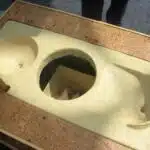

![How To Get Hair Out Of A Bathtub Drain 4 2/365 [Bathtub Drain]](https://green-life.blog/wp-content/uploads/2023/05/cOEu5edpkejq-150x150.jpg.webp)
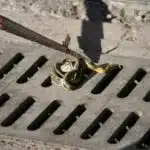



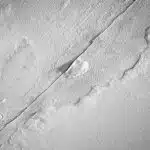

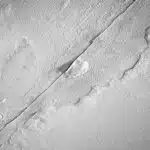


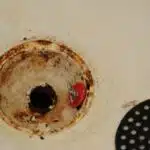



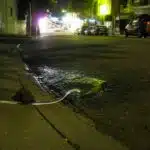

![How To Replace A Bathtub Drain In A Mobile Home 20 2/365 [Bathtub Drain]](https://green-life.blog/wp-content/uploads/2023/05/3ft8KAJsNnjq-150x150.jpg.webp)
